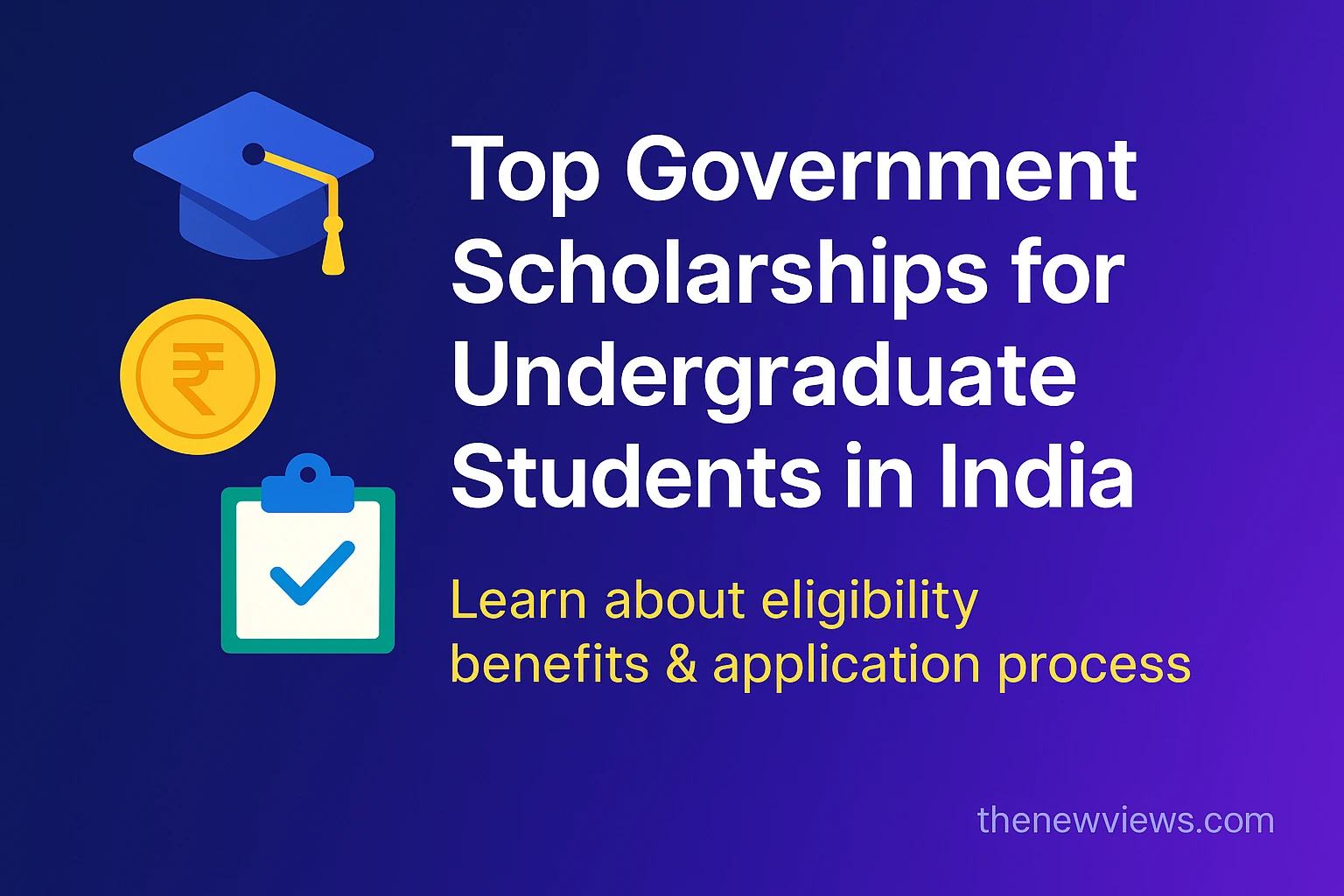Dreaming of college but worried about the cost?
There is Good news for you— the Indian government offers a variety of scholarships to help bright, deserving undergraduate students study without financial stress. From tuition fees to living expenses, these scholarships cover it all.
Discover Top Government Scholarships for undergraduate Students in India and learn how you can apply to make your college dreams come true!

Government Scholarships for Undergraduate Students in India – Overview
Many students in India dream of pursuing higher education, but financial constraints often stand in the way.
Government scholarships for undergraduate students aim to bridge this gap by offering financial support to talented and deserving youth across the country.
These scholarships are not just limited to tuition fees. They cover living expenses, study materials, and even travel in some cases. By reducing the financial burden, these scholarships encourage more students—especially those from economically weaker sections—to continue their studies without interruptions.
Why Should You Apply for Government Scholarships in India?
If you are wondering why you should apply for a government scholarship in India, here are some compelling reasons:
- Reduce financial stress: Scholarships help you cover tuition fees, accommodation, and other costs, so you can focus on your studies.
- Encourage academic excellence: Many schemes reward high-performing students, motivating them to maintain good grades.
- Boost your resume: Winning a scholarship shows commitment and achievement, making you stand out for future academic or professional opportunities.
- Support for marginalized groups: Several scholarships are designed specifically for SC, ST, OBC, EWS, and minority communities, promoting inclusive education.
Top Government Scholarships for Undergraduate Students in India
India offers a variety of government scholarships at both the central and state levels. Below are some of the most popular and impactful schemes for undergraduate students.
Central Sector Scheme for College and University Students (CSSS)
- Eligibility: Students who secured top positions in Class 12 exams from recognized boards and belong to families with an income below ₹8 lakh per annum.
- Scholarship amount: ₹10,000 per annum for the first three years of college and ₹20,000 per annum for postgraduate studies.
- Selection criteria: Based on Class 12 board exam performance and family income.
- Application period: Generally open from June to October.
This scholarship aims to support meritorious students in their higher education journey and reduce dropouts due to financial issues.
State Government Post Matric Scholarships
Almost every Indian state has its own Post Matric Scholarship schemes for undergraduate students. For example:
- Karnataka SSP Post Matric Scholarship: Covers tuition, maintenance allowance, and other compulsory fees for SC, ST, OBC, EWS, and minority students.
- Uttar Pradesh Post Matric Scholarship: Assists economically weaker students to continue their studies beyond Class 10.
Key highlights
- Offered to students belonging to SC, ST, OBC, EWS, and minority communities.
- Benefits include tuition fee reimbursement, hostel fee support, and annual stipends.
- Applications are usually processed through the respective state scholarship portals.
Scholarships from the Ministry of Minority Affairs
The Ministry of Minority Affairs offers the Post Matric Scholarship for Minorities, designed to support students from minority communities (Muslims, Christians, Sikhs, Buddhists, Jains, and Zoroastrians).
Important details
- Eligibility: Annual family income below ₹2 lakh, minimum 50% marks in the previous final examination.
- Scholarship benefits: Admission and tuition fee reimbursement up to ₹10,000 per annum and maintenance allowance up to ₹1,200 per month.
- Mode of application: Online via the National Scholarship Portal (NSP).
Prime Minister’s Scholarship Scheme
A special scheme for the wards of ex-servicemen, ex-coast guard personnel, and police personnel who were martyred during terror or Naxal attacks.
Scholarship features
- Eligibility: Dependent wards and widows of personnel from the Armed Forces and Central Armed Police Forces.
- Scholarship amount: ₹2,500 per month for boys and ₹3,000 per month for girls.
- Duration: Up to five years, depending on the course.
This scheme not only supports education but also recognizes the sacrifices of armed forces personnel.
L’Oréal India For Young Women in Science Scholarships
An inspiring initiative to encourage more women in STEM fields.
Key points
- Eligibility: Female students who scored at least 85% in Class 12 (science stream) and have a family income below ₹6 lakh per annum.
- Scholarship amount: Up to ₹1,00,000 per student per year.
- Courses covered: Undergraduate degrees in science, engineering, medical, or other scientific fields.
Reliance Foundation Undergraduate Scholarships
A relatively new yet impactful scholarship from the Reliance Foundation, aimed at empowering young talent.
Details
- Eligibility: First-year undergraduate students with annual family income below ₹15 lakh (priority given to incomes below ₹2.5 lakh).
- Scholarship amount: Up to ₹2 lakh over the duration of the course.
- Selection criteria: Based on merit (Class 12 performance) and need.
How to Apply for Government Scholarships for Undergraduate Students in India?
Applying for scholarships might seem overwhelming, but it becomes simpler with a clear plan. Here’s a step-by-step guide:
Step 1: Check eligibility
Before starting your application, carefully read the eligibility criteria for each scholarship. Verify:
- Income limits
- Academic requirements
- Category or community-specific conditions
Step 2: Register on the appropriate portal
Most central scholarships can be applied for through the National Scholarship Portal (NSP): https://scholarships.gov.in
State scholarships are usually available through state-specific portals (e.g., SSP for Karnataka, UP Scholarship portal, etc.).
Step 3: Prepare documents
Commonly required documents include:
- Aadhaar card
- Income certificate
- Caste certificate (if applicable)
- Class 10 and 12 mark sheets
- Bank account details
- Passport-size photographs
Step 4: Complete the application
Fill in all the required information accurately. Upload scanned copies of your documents in the correct formats.
Step 5: Submit and track
After submission, keep a copy of the application for your records and track the status online.
Requirements for Applying to Undergraduate Government Scholarships in India
Before applying, you should ensure you meet the following basic requirements:
- Indian citizenship: Only Indian citizens are eligible.
- Admission to a recognized institution: Must be enrolled in an undergraduate program approved by a recognized university or college.
- Income threshold: Family income should fall within the limit specified by each scholarship scheme.
- Academic performance: Minimum marks requirement (usually around 50% or above).
Benefits of Government Scholarships for College Students in India
Scholarships are not just about money. They come with a wide range of tangible and intangible benefits:
- Financial independence: Reduce dependency on loans or family support.
- Motivation to excel: Students often perform better academically when they have support.
- Career advantages: Scholarships improve your academic profile and open doors for future opportunities.
- Encouragement for diversity: Support for minority and economically weaker sections promotes inclusive education.
Important Dates and Application Timeline for Government Scholarships
Below is a general timeline to help you plan your application:
| Activity | Typical Timeline |
|---|---|
| Application opens | June to August |
| Last date to apply | September to October |
| Verification by institutions | October to November |
| Scholarship award announcement | December to January |
| Funds disbursed | January to March |
Note: These dates can vary each year. Always check the official scholarship websites for the most up-to-date schedule.
Common Mistakes to Avoid While Applying for Scholarships
Many deserving students lose out on scholarships due to avoidable mistakes. Here’s what you should avoid:
- Missing deadlines: Always keep track of application dates.
- Incomplete forms: Incomplete applications are often rejected without notice.
- Incorrect information: Ensure all details, including spelling and numbers, are accurate.
- Improper document uploads: Follow format and file size instructions strictly.
Frequently Asked Questions about Undergraduate Scholarships in India
Can I apply for more than one Undergraduate scholarship at the same time?
Yes, you can apply for multiple scholarships. However, some schemes do not allow simultaneous disbursement of more than one government-funded scholarship. Always check specific rules.
What happens if I fail a year?
Scholarship renewal usually requires you to pass each academic year. If you fail, your scholarship may be discontinued.
Do I need to repay the Government Scholarships amount?
No. Scholarships are financial grants and do not need to be repaid.
Are government scholarships only for full-time courses?
Yes, government scholarships are generally for regular full-time degree courses.
Conclusion
Applying for a government scholarship can change your academic journey by relieving financial stress and motivating you to achieve more. India offers various scholarship options tailored for different communities, academic achievers, and economically weaker sections.
Don’t wait until the last moment—check your eligibility, prepare your documents, and apply on time. Your dream college life might be more affordable than you think!

1 thought on “Top Government Scholarships for undergraduate Students in India: Eligibility, Benefits & How to Apply”